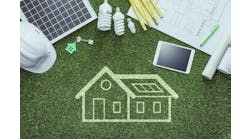Our Building Backbone connects to our wireless airways, which in turn connects our building users to the world. We need to explore how to make the building user experience (UX) seamless and amazing.
This is the next chapter in our Building Book of Digital Transformation. This online resource started over two years ago with Sensing the Change, and I still find myself asking, are we fully sensing the changes IoT is bringing to our industry? It’s hard to believe we are now more than 50 chapter in to our ongoing journey!
Some folks in the industry call me a Storyteller. I first took that as a shot to the value of my commentary, but I have since come to embrace role as just one more way to help get my messages out.
In this post from controltrends.org, I am referred to as an “Industry Oracle.” Although I am guilty of presenting and even preaching our present evolution as interpreted by me into a storyline, I think more of myself as a Content Connector linking to what is published and now read online. I am having fun storytelling, preaching, prophesying and simply sharing my views and observations. Thanks for your tolerance.
Our Wireless Skin, when connected to the urban and global airways that transmit mobile data from the smart city and our buildings must seamlessly provide a friendly, open transition to our building backbone of glass and steel.
In my opinion, the next 5G movement will not come from the mobile cell service providers as they are now immobilized with the scope of change and functional creep of 5G. It will be the progressively informed building owners that will move to their own in-building wireless to provide a never-before-seen user experience (including location services with occupant heat mapping).
This may be driven in retrofit faster than new construction as an old building without network infrastructure needs DAS (Distributed Antenna System) to provide existing cell phone survival, and near 5G is easy to piggyback on new DAS.
It appears clear to me the low voltage power for our edge devices will come from a USB plug-in at every light fixture or else be generated autonomously—not POE—because future tenant networking infrastructure will be wireless.
As mobility data is amassed from ride-hailing, dockless bikes and e-scooters, cities need tools to responsibly track, store, and analyze it. This article from www.axios.com explains how Mobility data could give cities new tools to improve equity.
We need to add our buildings to this list of things amassing mobility data and determine how our building data fits into this movement.
Municipalities across the country have joined together to create a new global non-profit organization called the Open Mobility Foundation to support the development of open-source software that provides scalable mobility solutions for cities.
From this article by Troy Harvey, CEO, PassiveLogic, Establishing a Smart Building Industry Standard:
We spend the first hour of a meeting establishing what we mean by smart, how smart is smart, navigating disbelief, educating about new technology, and finally arriving at common ground.Jamthe’s thoughts about autonomous cars and AIX has many messages for Building User Connection. The development of today’s electric cars provide insights into how one day buildings will be able to deliver amazing user connection and user experience.
These cars have become off- and on-the-grid, micro-generating mobile platforms that provide user interfaces directly using vision, voice, sounds, graphics, physical and virtual interactions. This personal environment welcomes the user's own phone with wireless charger and screen connection. A myriad of sensors makes the vehicle aware of its surroundings. Our buildings need the same amount of varied sensors per virtual docking work environment.
The complication of many technologies in close proximately is softening with software and user connection. Information presentation in several formats shows clearly that, although the relationships are complex, the results can be simple and obvious. Real-time dynamic presentation and interaction is everywhere.
We need to explore how we can bring our virtual mobile desk experiences in our buildings closer to that of being behind the wheel of a new vehicle. We need to evolve our building user connection with Android Auto and Apple Car Play thinking, connecting our location and building delight services. Voice and the continuation of our personal interfaces are a big part of this.
Delighting the user means creating a personal connection. This means complete control of heating, cooling, lighting, and ventilation on an individual basis (i.e. seat heaters), plus the ability to navigate a building’s its energy interaction complexity while the building is in constant communication with us. It is aware, responding to not only its environment but ours and our mobile presence.
Brad White, Principle, SES Consulting, started this discussion in May of 2018 with this article, Thermal Delight and The Coming Revolution in Personalized Comfort. We engineers sometimes get so caught up in HOW to do something we lose sight of WHY we’re trying to do it in the first place.This article from Scott Cochrane, CEO Cochrane Supply & Engineering, states:
It’s becoming an IP utopia overnight and with all of these new choices to enhance applications; owners are diving in for all sorts of digital retrofit business opportunities and enhancing the occupant experience, all while increasing energy and business efficiencies. Oh boy, can’t wait for next year, all that new work!
As we change the work environment is changing even faster. As outlined in this article from techcrunch.com, WeWork, now known as The We Company, has announced the acquisition of a rival co-working business, Spacious. The company has since converted dozens of restaurants in New York and San Francisco into weekday workspaces.
The home is changing even faster, adding pressure to occupant expectations. RoomMe is a small, smoke-alarm like device that you stick on your ceiling and it senses who you are (thanks to your smartphone). It then adapts the connected devices in that room to your personal preferences.
Over eight years ago we formed a small group of folks we deemed to be in the business of creating connection, our Online Connection Communities Collaboration LinkedIn group. We meet every year to discuss our common connection concerns, open standards and how we all can collaborate. This year's planned meeting, Our Eighth Annual Connection Community Collaboratory, is themed "2020 Vision" AHRExpo Orlando. From the Collaboratory’s description at AHRExpo.com:
The connection community is growing while rapidly changing how we connected with a plethora of enterprise software platforms and new connection standards like 5G CBRS. We are reminded of the dot-com days of radical change. Can so many platforms exist without dot-crashing? Hard to say as these platforms require an amazing community of practice to be successful, which has more value than the actual platforms. Maybe a better way to view each platform is as a community of practice COP, not a software identity. In this manner, I feel success can be achieved using the COP that created that platform. It is not the secret sauce of the platforms but the people that bring the solutions and structure and never before done features. When they are removed, the platform value is questioned. Recalibrate for 2020 provides an amazing capture with opinion and observation. At our 8th Collaboratory, experts will speak of their 2020 vision. Lots of scopes to be blurred out in only five minutes by the industry expert who will also provide their visions for Integrating the OCCUPANT EXPERIENCE into Smart Buildings.
Want to discuss in real-time our 2020 vision? Join us in Orlando! AutomatedBuildings.com is offering twelve education sessions at AHRExpo 2020.
In all we do we now, we need to support and educate ourselves in "Building User Connection."


